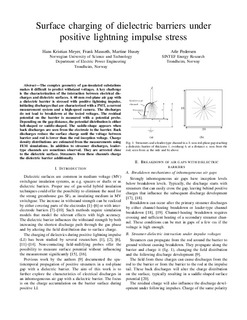| dc.contributor.author | Hygen Meyer, Hans Kristian | |
| dc.contributor.author | Mauseth, Frank | |
| dc.contributor.author | Pedersen, Per Atle | |
| dc.contributor.author | Husøy, Martine | |
| dc.date.accessioned | 2018-02-14T13:31:46Z | |
| dc.date.available | 2018-02-14T13:31:46Z | |
| dc.date.created | 2017-11-08T11:20:24Z | |
| dc.date.issued | 2017 | |
| dc.identifier.isbn | 978-1-5090-4653-9 | |
| dc.identifier.uri | http://hdl.handle.net/11250/2484736 | |
| dc.description.abstract | The complex geometry of gas-insulated substations makes it difficult to predict withstand voltages. A key challenge is the characterization of the interaction between electrical discharges and dielectric surfaces. A 60 mm rod-plane air gap with a dielectric barrier is stressed with positive lightning impulse, initiating discharges that are characterized with a PMT, a current measurement system and a high-speed camera. The discharges do not lead to breakdown at the tested voltages. The residual potential on the barrier is measured with a potential probe. Depending on the gap distance, the potential distribution is either bell-shaped or saddle-shaped. The saddle-shape appears when back discharges are seen from the electrode to the barrier. Back discharges reduce the surface charge until the voltage between barrier and rod is lower than the rod inception voltage. Charge density distributions are estimated from the measurements using FEM simulations. In addition to streamer discharges, leadertype channels are sometimes observed. They are arrested close to the dielectric surface. Streamers from these channels charge the dielectric barrier additionally. | nb_NO |
| dc.language.iso | eng | nb_NO |
| dc.publisher | Institute of Electrical and Electronics Engineers (IEEE) | nb_NO |
| dc.relation.ispartof | 2017 Annual Conference on Electric Insulation and Dielectric Phenomena - CEIDP 2017 | |
| dc.title | Surface charging of dielectric barriers under positive lightning impulse stress | nb_NO |
| dc.type | Chapter | nb_NO |
| dc.description.version | acceptedVersion | nb_NO |
| dc.source.pagenumber | 802-806 | nb_NO |
| dc.identifier.cristin | 1512160 | |
| dc.description.localcode | © 2017 IEEE. Personal use of this material is permitted. Permission from IEEE must be obtained for all other uses, in any current or future media, including reprinting/republishing this material for advertising or promotional purposes, creating new collective works, for resale or redistribution to servers or lists, or reuse of any copyrighted component of this work in other works. | nb_NO |
| cristin.unitcode | 194,63,20,0 | |
| cristin.unitname | Institutt for elkraftteknikk | |
| cristin.ispublished | true | |
| cristin.fulltext | postprint | |
| cristin.qualitycode | 1 | |
